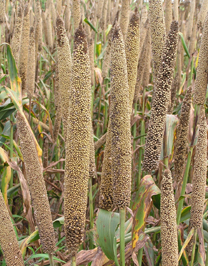Millet
“Millet” is a name that has been applied to several different annual summer grasses used for hay, pasture, silage, and grain. The millets most commonly cultivated in Kentucky, pearl millet and foxtail millet, are grown primarily as a forage for temporary pasture. If properly managed, these millets can provide high yields of good quality forage in a short period, without the risk of prussic acid poisoning. Pearl millet (Pennisetum glaucum) is higher yielding than foxtail millet and regrows after harvest if sufficient stubble is left. Dwarf varieties, which are leafier and more suited for grazing, are also available. Foxtail millet (Setaria italica) is a lower-yielding grass that will not regrow to produce another harvest. Because it is shorter and finer-stemmed, it is easier to harvest as hay.
Marketing
 Millet is mainly grown in Kentucky for use as a forage. Because pesticides are generally not applied, millets could be grown organically for the organic livestock feed market. Some pearl millet cultivars have also been developed for their grain and show potential as poultry and livestock feed. Millet seed has also been grown as wild bird feeds and could be marketed in birdseed mixes.
Millet is mainly grown in Kentucky for use as a forage. Because pesticides are generally not applied, millets could be grown organically for the organic livestock feed market. Some pearl millet cultivars have also been developed for their grain and show potential as poultry and livestock feed. Millet seed has also been grown as wild bird feeds and could be marketed in birdseed mixes.
Production
Foxtail and pearl millets are planted from the first of May until the end of July in Kentucky. Later plantings reduce harvests and total yields. Seeding at two or more planting dates helps in managing harvests. The seed can be broadcast and cultipacked, or seeded with a grain drill into a well-prepared, firm seedbed. Seed can also be planted without tillage by using a no-till drill. Foxtail and pearl millet need a good supply of nutrients to make high yields.
See the full crop profile and other resources below:

